Detailed Analysis of The Abraaj Group Scandal and Collapse Case Study
VerifiedAdded on 2022/12/28
|9
|2619
|34
Case Study
AI Summary
This case study examines the Abraaj Group, a Dubai-based private equity firm, and its dramatic collapse due to allegations of fraud and financial mismanagement. The report delves into the assessment of risks, including business, compliance, and financial risks, highlighting the firm's failure to effectively manage its market position and maintain accurate financial reporting. It analyzes Abraaj's responses to its risk exposure, the gaps and shortfalls in its approach, and the relevant aspects of risk governance and regulatory failures. The scandal involved accusations of misrepresenting financial performance, misappropriating investor funds, and failing to comply with financial regulations, leading to the arrest of key executives and highlighting significant loopholes in international regulatory oversight. The case study concludes by emphasizing the need for enhanced regulatory scrutiny, internal controls, and transparent financial practices to prevent similar scandals in the future, offering valuable insights into the complexities of financial risk management and corporate governance.
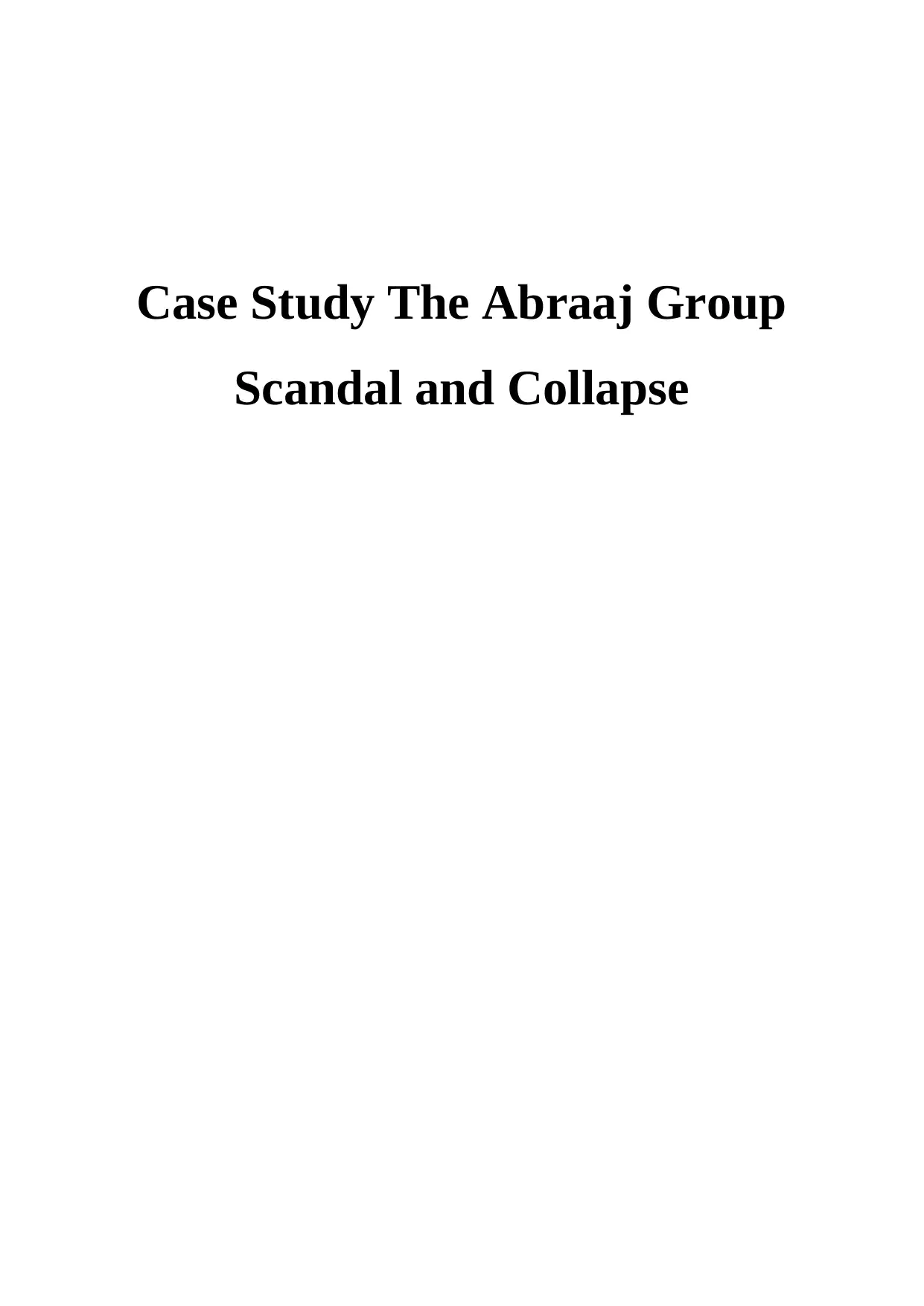
Case Study The Abraaj Group
Scandal and Collapse
Scandal and Collapse
Paraphrase This Document
Need a fresh take? Get an instant paraphrase of this document with our AI Paraphraser

TABLE OF CONTENTS
INTRODUCTION......................................................................................................................3
ASSESSMENT OF RISK..........................................................................................................3
RISK RESPONSE......................................................................................................................5
Abraaj’s response to its risk exposure....................................................................................5
Gaps and shortfalls in Abraaj’s approach..............................................................................5
Relevant aspects of risk governance and regulatory risk.......................................................6
CONCLUSION..........................................................................................................................7
REFERENCES...........................................................................................................................8
INTRODUCTION......................................................................................................................3
ASSESSMENT OF RISK..........................................................................................................3
RISK RESPONSE......................................................................................................................5
Abraaj’s response to its risk exposure....................................................................................5
Gaps and shortfalls in Abraaj’s approach..............................................................................5
Relevant aspects of risk governance and regulatory risk.......................................................6
CONCLUSION..........................................................................................................................7
REFERENCES...........................................................................................................................8
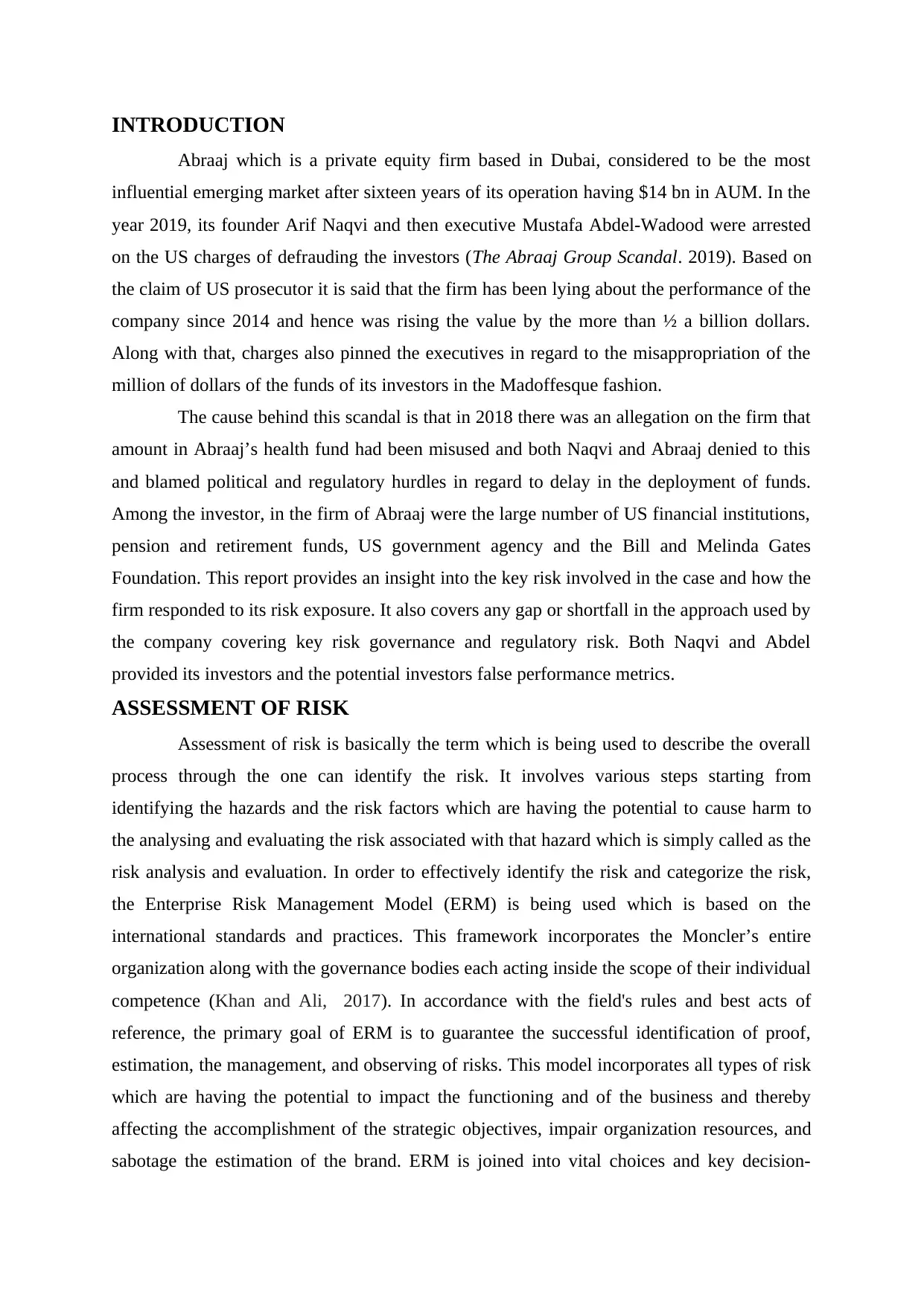
INTRODUCTION
Abraaj which is a private equity firm based in Dubai, considered to be the most
influential emerging market after sixteen years of its operation having $14 bn in AUM. In the
year 2019, its founder Arif Naqvi and then executive Mustafa Abdel-Wadood were arrested
on the US charges of defrauding the investors (The Abraaj Group Scandal. 2019). Based on
the claim of US prosecutor it is said that the firm has been lying about the performance of the
company since 2014 and hence was rising the value by the more than ½ a billion dollars.
Along with that, charges also pinned the executives in regard to the misappropriation of the
million of dollars of the funds of its investors in the Madoffesque fashion.
The cause behind this scandal is that in 2018 there was an allegation on the firm that
amount in Abraaj’s health fund had been misused and both Naqvi and Abraaj denied to this
and blamed political and regulatory hurdles in regard to delay in the deployment of funds.
Among the investor, in the firm of Abraaj were the large number of US financial institutions,
pension and retirement funds, US government agency and the Bill and Melinda Gates
Foundation. This report provides an insight into the key risk involved in the case and how the
firm responded to its risk exposure. It also covers any gap or shortfall in the approach used by
the company covering key risk governance and regulatory risk. Both Naqvi and Abdel
provided its investors and the potential investors false performance metrics.
ASSESSMENT OF RISK
Assessment of risk is basically the term which is being used to describe the overall
process through the one can identify the risk. It involves various steps starting from
identifying the hazards and the risk factors which are having the potential to cause harm to
the analysing and evaluating the risk associated with that hazard which is simply called as the
risk analysis and evaluation. In order to effectively identify the risk and categorize the risk,
the Enterprise Risk Management Model (ERM) is being used which is based on the
international standards and practices. This framework incorporates the Moncler’s entire
organization along with the governance bodies each acting inside the scope of their individual
competence (Khan and Ali, 2017). In accordance with the field's rules and best acts of
reference, the primary goal of ERM is to guarantee the successful identification of proof,
estimation, the management, and observing of risks. This model incorporates all types of risk
which are having the potential to impact the functioning and of the business and thereby
affecting the accomplishment of the strategic objectives, impair organization resources, and
sabotage the estimation of the brand. ERM is joined into vital choices and key decision-
Abraaj which is a private equity firm based in Dubai, considered to be the most
influential emerging market after sixteen years of its operation having $14 bn in AUM. In the
year 2019, its founder Arif Naqvi and then executive Mustafa Abdel-Wadood were arrested
on the US charges of defrauding the investors (The Abraaj Group Scandal. 2019). Based on
the claim of US prosecutor it is said that the firm has been lying about the performance of the
company since 2014 and hence was rising the value by the more than ½ a billion dollars.
Along with that, charges also pinned the executives in regard to the misappropriation of the
million of dollars of the funds of its investors in the Madoffesque fashion.
The cause behind this scandal is that in 2018 there was an allegation on the firm that
amount in Abraaj’s health fund had been misused and both Naqvi and Abraaj denied to this
and blamed political and regulatory hurdles in regard to delay in the deployment of funds.
Among the investor, in the firm of Abraaj were the large number of US financial institutions,
pension and retirement funds, US government agency and the Bill and Melinda Gates
Foundation. This report provides an insight into the key risk involved in the case and how the
firm responded to its risk exposure. It also covers any gap or shortfall in the approach used by
the company covering key risk governance and regulatory risk. Both Naqvi and Abdel
provided its investors and the potential investors false performance metrics.
ASSESSMENT OF RISK
Assessment of risk is basically the term which is being used to describe the overall
process through the one can identify the risk. It involves various steps starting from
identifying the hazards and the risk factors which are having the potential to cause harm to
the analysing and evaluating the risk associated with that hazard which is simply called as the
risk analysis and evaluation. In order to effectively identify the risk and categorize the risk,
the Enterprise Risk Management Model (ERM) is being used which is based on the
international standards and practices. This framework incorporates the Moncler’s entire
organization along with the governance bodies each acting inside the scope of their individual
competence (Khan and Ali, 2017). In accordance with the field's rules and best acts of
reference, the primary goal of ERM is to guarantee the successful identification of proof,
estimation, the management, and observing of risks. This model incorporates all types of risk
which are having the potential to impact the functioning and of the business and thereby
affecting the accomplishment of the strategic objectives, impair organization resources, and
sabotage the estimation of the brand. ERM is joined into vital choices and key decision-
⊘ This is a preview!⊘
Do you want full access?
Subscribe today to unlock all pages.

Trusted by 1+ million students worldwide

making processes. The risk might be inward or outer relying upon whether they are
distinguished inside or outside the company. Specifically, external risks are connected to
industry and market circumstances as well as the stakeholder’s perception to it. In this model,
the risk is divided into 4 categories which are- strategic, business, compliance and financial
risk.
The main objective of this model is to identify the risk and segregate it into different
categories which makes it very easy for the business entity in effectively managing its risks
by undertaking specific prevention and controllable measures. These actions or the measures
can be implemented into the company processes in order to eliminate the risk along with
reducing the likelihood of occurrence of it again, and affecting the business performance. The
risk assessment recognizes all the threats and risks along with the risk owners, answerable for
dealing with the actual risk and the connected control framework, and for actualizing or
improving relief measures (Yang, Ishtiaq and Anwar, 2018). All the threats, the assessment
of the applicable internal control framework and related mitigation activities are recorded in a
Risks Register, which is upgraded consistently with risk owners, based on a yearly
arrangement affirmed by the Board of Directors with the help of the Control, Risks and
Sustainability Committee. The arrangement is occasionally updated to incorporate any new
components of danger as well as to reflect any rise in the probability of events or in the
degree of effects.
Therefore, based upon this framework, the risks pertaining to this case are stated
underneath.
Business risks: Abraaj firm failed to effectively follow the market in which it was
operating which has led to be lose control and reporting system. The company despite its
successful inception, the company started struggling as year on year the accounts of it
displayed a multimillion dollar losses. In addition to this, the revenue of the outweighed the
bloated costs and in order to reduce the gap the company borrowed funds (Saeidi and et.al.,
2019). In the year 2018, the financing cost reached to $41 mn. Two years back, the fir
attempted to divest assets which involves the $1.8 bn stake in Pakistani utility firm in order to
avoid the situation of cash crunch. All these losses were not disclosed and reported in the
financial reports of the company.
Compliance risks: The firm failed to comply with the financial reporting framework
and also used tactics in depicting better financial position and performance. For instance, the
company borrowed money just before the financial reporting dates with the purpose of
distinguished inside or outside the company. Specifically, external risks are connected to
industry and market circumstances as well as the stakeholder’s perception to it. In this model,
the risk is divided into 4 categories which are- strategic, business, compliance and financial
risk.
The main objective of this model is to identify the risk and segregate it into different
categories which makes it very easy for the business entity in effectively managing its risks
by undertaking specific prevention and controllable measures. These actions or the measures
can be implemented into the company processes in order to eliminate the risk along with
reducing the likelihood of occurrence of it again, and affecting the business performance. The
risk assessment recognizes all the threats and risks along with the risk owners, answerable for
dealing with the actual risk and the connected control framework, and for actualizing or
improving relief measures (Yang, Ishtiaq and Anwar, 2018). All the threats, the assessment
of the applicable internal control framework and related mitigation activities are recorded in a
Risks Register, which is upgraded consistently with risk owners, based on a yearly
arrangement affirmed by the Board of Directors with the help of the Control, Risks and
Sustainability Committee. The arrangement is occasionally updated to incorporate any new
components of danger as well as to reflect any rise in the probability of events or in the
degree of effects.
Therefore, based upon this framework, the risks pertaining to this case are stated
underneath.
Business risks: Abraaj firm failed to effectively follow the market in which it was
operating which has led to be lose control and reporting system. The company despite its
successful inception, the company started struggling as year on year the accounts of it
displayed a multimillion dollar losses. In addition to this, the revenue of the outweighed the
bloated costs and in order to reduce the gap the company borrowed funds (Saeidi and et.al.,
2019). In the year 2018, the financing cost reached to $41 mn. Two years back, the fir
attempted to divest assets which involves the $1.8 bn stake in Pakistani utility firm in order to
avoid the situation of cash crunch. All these losses were not disclosed and reported in the
financial reports of the company.
Compliance risks: The firm failed to comply with the financial reporting framework
and also used tactics in depicting better financial position and performance. For instance, the
company borrowed money just before the financial reporting dates with the purpose of
Paraphrase This Document
Need a fresh take? Get an instant paraphrase of this document with our AI Paraphraser
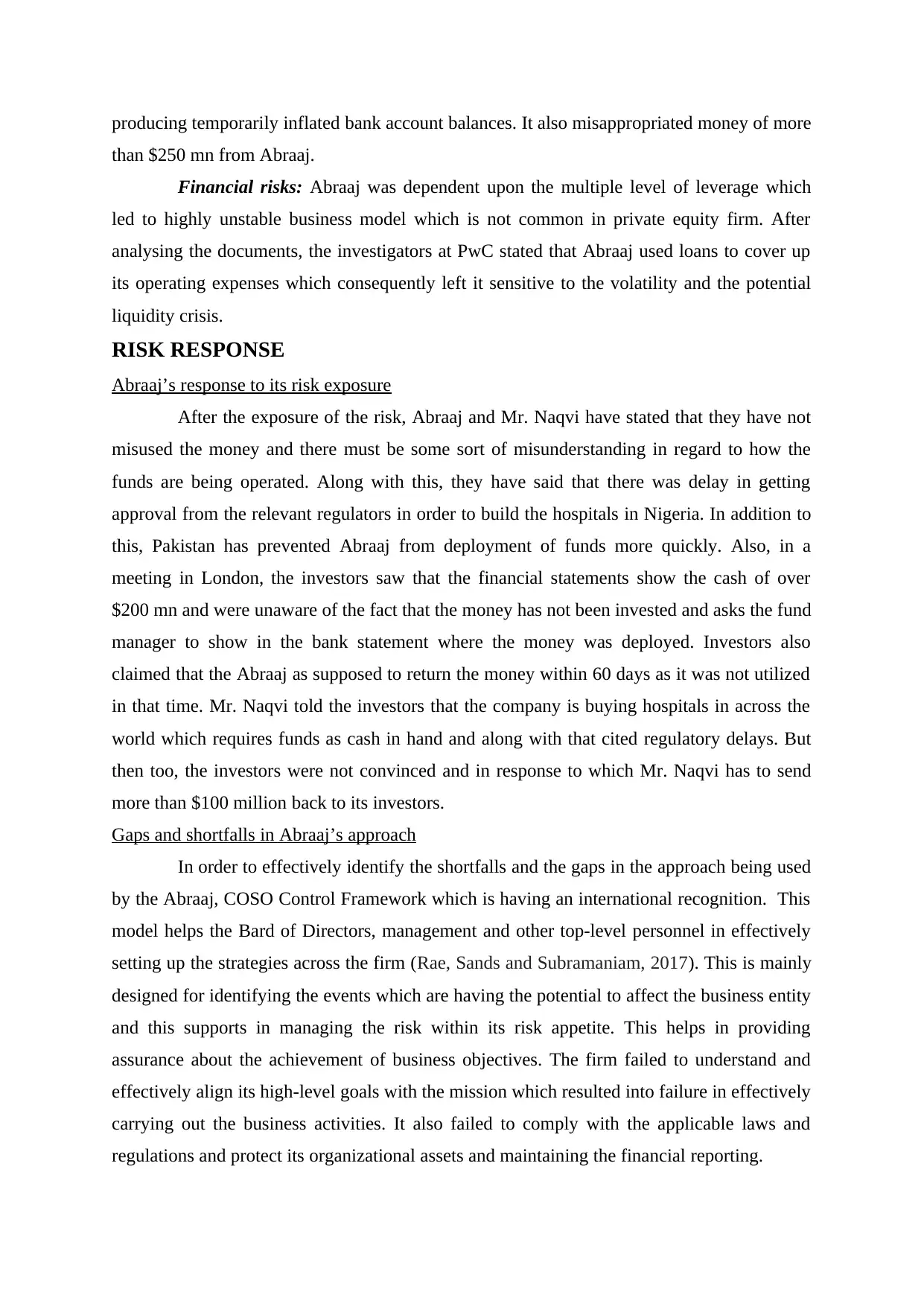
producing temporarily inflated bank account balances. It also misappropriated money of more
than $250 mn from Abraaj.
Financial risks: Abraaj was dependent upon the multiple level of leverage which
led to highly unstable business model which is not common in private equity firm. After
analysing the documents, the investigators at PwC stated that Abraaj used loans to cover up
its operating expenses which consequently left it sensitive to the volatility and the potential
liquidity crisis.
RISK RESPONSE
Abraaj’s response to its risk exposure
After the exposure of the risk, Abraaj and Mr. Naqvi have stated that they have not
misused the money and there must be some sort of misunderstanding in regard to how the
funds are being operated. Along with this, they have said that there was delay in getting
approval from the relevant regulators in order to build the hospitals in Nigeria. In addition to
this, Pakistan has prevented Abraaj from deployment of funds more quickly. Also, in a
meeting in London, the investors saw that the financial statements show the cash of over
$200 mn and were unaware of the fact that the money has not been invested and asks the fund
manager to show in the bank statement where the money was deployed. Investors also
claimed that the Abraaj as supposed to return the money within 60 days as it was not utilized
in that time. Mr. Naqvi told the investors that the company is buying hospitals in across the
world which requires funds as cash in hand and along with that cited regulatory delays. But
then too, the investors were not convinced and in response to which Mr. Naqvi has to send
more than $100 million back to its investors.
Gaps and shortfalls in Abraaj’s approach
In order to effectively identify the shortfalls and the gaps in the approach being used
by the Abraaj, COSO Control Framework which is having an international recognition. This
model helps the Bard of Directors, management and other top-level personnel in effectively
setting up the strategies across the firm (Rae, Sands and Subramaniam, 2017). This is mainly
designed for identifying the events which are having the potential to affect the business entity
and this supports in managing the risk within its risk appetite. This helps in providing
assurance about the achievement of business objectives. The firm failed to understand and
effectively align its high-level goals with the mission which resulted into failure in effectively
carrying out the business activities. It also failed to comply with the applicable laws and
regulations and protect its organizational assets and maintaining the financial reporting.
than $250 mn from Abraaj.
Financial risks: Abraaj was dependent upon the multiple level of leverage which
led to highly unstable business model which is not common in private equity firm. After
analysing the documents, the investigators at PwC stated that Abraaj used loans to cover up
its operating expenses which consequently left it sensitive to the volatility and the potential
liquidity crisis.
RISK RESPONSE
Abraaj’s response to its risk exposure
After the exposure of the risk, Abraaj and Mr. Naqvi have stated that they have not
misused the money and there must be some sort of misunderstanding in regard to how the
funds are being operated. Along with this, they have said that there was delay in getting
approval from the relevant regulators in order to build the hospitals in Nigeria. In addition to
this, Pakistan has prevented Abraaj from deployment of funds more quickly. Also, in a
meeting in London, the investors saw that the financial statements show the cash of over
$200 mn and were unaware of the fact that the money has not been invested and asks the fund
manager to show in the bank statement where the money was deployed. Investors also
claimed that the Abraaj as supposed to return the money within 60 days as it was not utilized
in that time. Mr. Naqvi told the investors that the company is buying hospitals in across the
world which requires funds as cash in hand and along with that cited regulatory delays. But
then too, the investors were not convinced and in response to which Mr. Naqvi has to send
more than $100 million back to its investors.
Gaps and shortfalls in Abraaj’s approach
In order to effectively identify the shortfalls and the gaps in the approach being used
by the Abraaj, COSO Control Framework which is having an international recognition. This
model helps the Bard of Directors, management and other top-level personnel in effectively
setting up the strategies across the firm (Rae, Sands and Subramaniam, 2017). This is mainly
designed for identifying the events which are having the potential to affect the business entity
and this supports in managing the risk within its risk appetite. This helps in providing
assurance about the achievement of business objectives. The firm failed to understand and
effectively align its high-level goals with the mission which resulted into failure in effectively
carrying out the business activities. It also failed to comply with the applicable laws and
regulations and protect its organizational assets and maintaining the financial reporting.
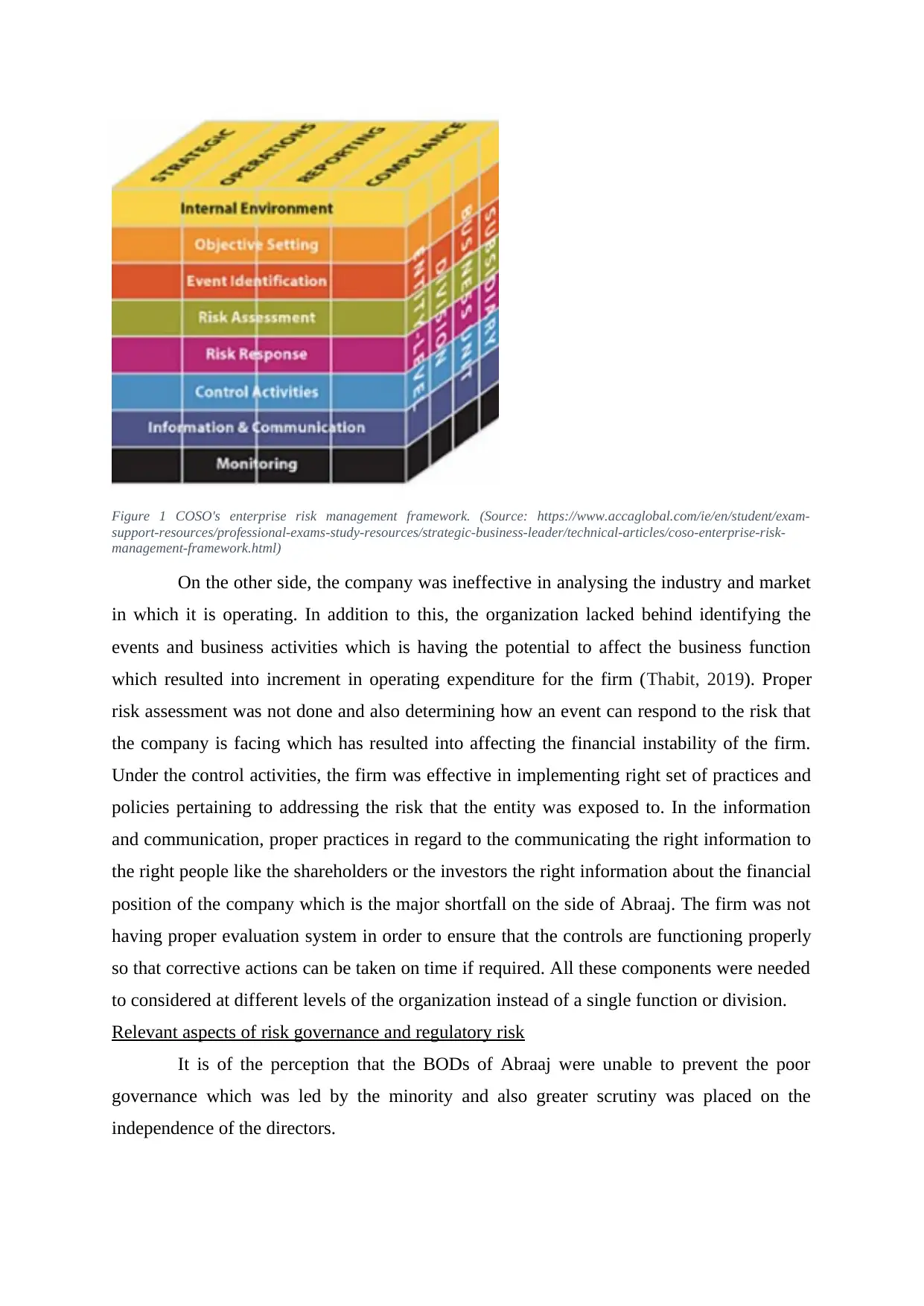
Figure 1 COSO's enterprise risk management framework. (Source: https://www.accaglobal.com/ie/en/student/exam-
support-resources/professional-exams-study-resources/strategic-business-leader/technical-articles/coso-enterprise-risk-
management-framework.html)
On the other side, the company was ineffective in analysing the industry and market
in which it is operating. In addition to this, the organization lacked behind identifying the
events and business activities which is having the potential to affect the business function
which resulted into increment in operating expenditure for the firm (Thabit, 2019). Proper
risk assessment was not done and also determining how an event can respond to the risk that
the company is facing which has resulted into affecting the financial instability of the firm.
Under the control activities, the firm was effective in implementing right set of practices and
policies pertaining to addressing the risk that the entity was exposed to. In the information
and communication, proper practices in regard to the communicating the right information to
the right people like the shareholders or the investors the right information about the financial
position of the company which is the major shortfall on the side of Abraaj. The firm was not
having proper evaluation system in order to ensure that the controls are functioning properly
so that corrective actions can be taken on time if required. All these components were needed
to considered at different levels of the organization instead of a single function or division.
Relevant aspects of risk governance and regulatory risk
It is of the perception that the BODs of Abraaj were unable to prevent the poor
governance which was led by the minority and also greater scrutiny was placed on the
independence of the directors.
support-resources/professional-exams-study-resources/strategic-business-leader/technical-articles/coso-enterprise-risk-
management-framework.html)
On the other side, the company was ineffective in analysing the industry and market
in which it is operating. In addition to this, the organization lacked behind identifying the
events and business activities which is having the potential to affect the business function
which resulted into increment in operating expenditure for the firm (Thabit, 2019). Proper
risk assessment was not done and also determining how an event can respond to the risk that
the company is facing which has resulted into affecting the financial instability of the firm.
Under the control activities, the firm was effective in implementing right set of practices and
policies pertaining to addressing the risk that the entity was exposed to. In the information
and communication, proper practices in regard to the communicating the right information to
the right people like the shareholders or the investors the right information about the financial
position of the company which is the major shortfall on the side of Abraaj. The firm was not
having proper evaluation system in order to ensure that the controls are functioning properly
so that corrective actions can be taken on time if required. All these components were needed
to considered at different levels of the organization instead of a single function or division.
Relevant aspects of risk governance and regulatory risk
It is of the perception that the BODs of Abraaj were unable to prevent the poor
governance which was led by the minority and also greater scrutiny was placed on the
independence of the directors.
⊘ This is a preview!⊘
Do you want full access?
Subscribe today to unlock all pages.

Trusted by 1+ million students worldwide
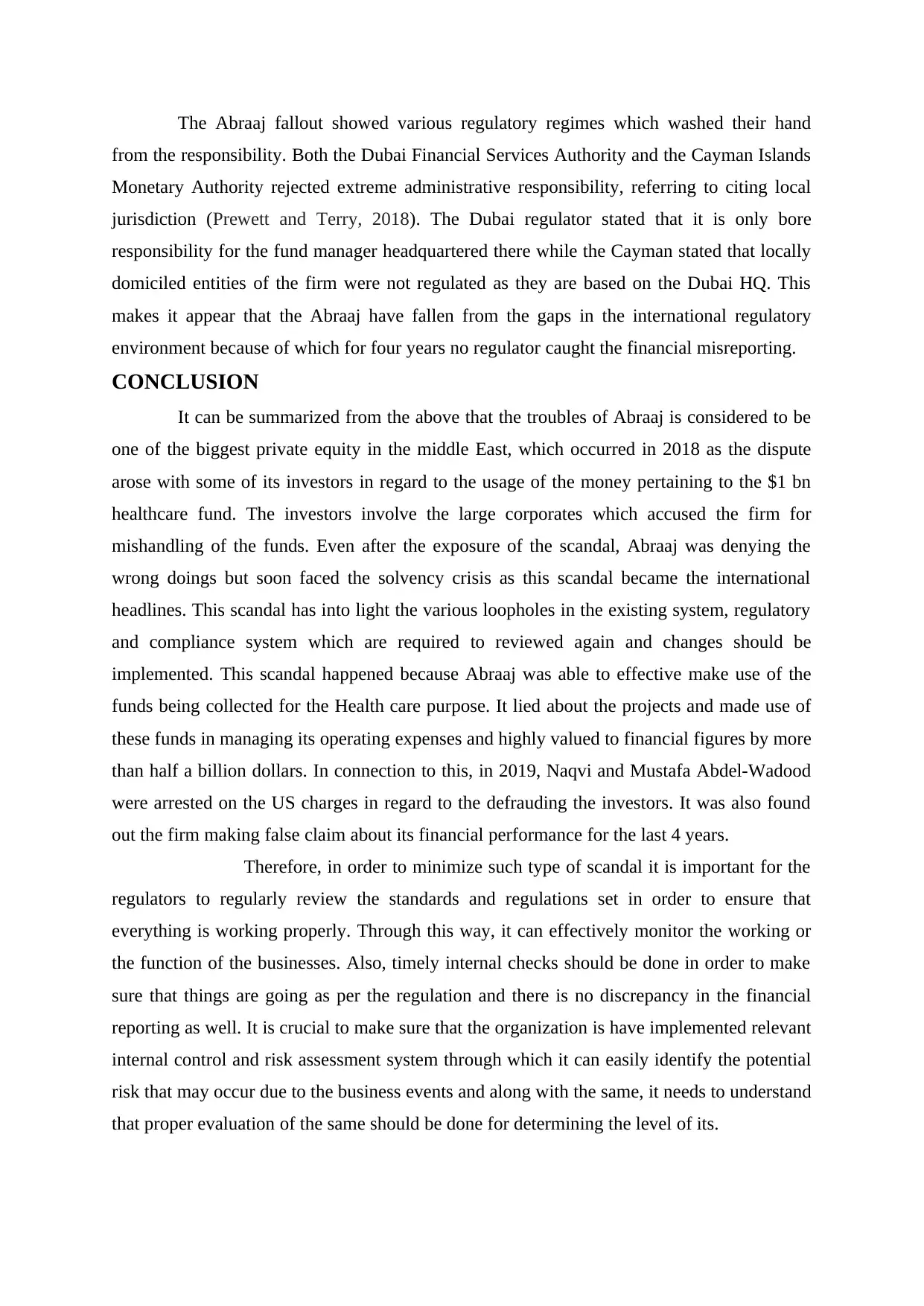
The Abraaj fallout showed various regulatory regimes which washed their hand
from the responsibility. Both the Dubai Financial Services Authority and the Cayman Islands
Monetary Authority rejected extreme administrative responsibility, referring to citing local
jurisdiction (Prewett and Terry, 2018). The Dubai regulator stated that it is only bore
responsibility for the fund manager headquartered there while the Cayman stated that locally
domiciled entities of the firm were not regulated as they are based on the Dubai HQ. This
makes it appear that the Abraaj have fallen from the gaps in the international regulatory
environment because of which for four years no regulator caught the financial misreporting.
CONCLUSION
It can be summarized from the above that the troubles of Abraaj is considered to be
one of the biggest private equity in the middle East, which occurred in 2018 as the dispute
arose with some of its investors in regard to the usage of the money pertaining to the $1 bn
healthcare fund. The investors involve the large corporates which accused the firm for
mishandling of the funds. Even after the exposure of the scandal, Abraaj was denying the
wrong doings but soon faced the solvency crisis as this scandal became the international
headlines. This scandal has into light the various loopholes in the existing system, regulatory
and compliance system which are required to reviewed again and changes should be
implemented. This scandal happened because Abraaj was able to effective make use of the
funds being collected for the Health care purpose. It lied about the projects and made use of
these funds in managing its operating expenses and highly valued to financial figures by more
than half a billion dollars. In connection to this, in 2019, Naqvi and Mustafa Abdel-Wadood
were arrested on the US charges in regard to the defrauding the investors. It was also found
out the firm making false claim about its financial performance for the last 4 years.
Therefore, in order to minimize such type of scandal it is important for the
regulators to regularly review the standards and regulations set in order to ensure that
everything is working properly. Through this way, it can effectively monitor the working or
the function of the businesses. Also, timely internal checks should be done in order to make
sure that things are going as per the regulation and there is no discrepancy in the financial
reporting as well. It is crucial to make sure that the organization is have implemented relevant
internal control and risk assessment system through which it can easily identify the potential
risk that may occur due to the business events and along with the same, it needs to understand
that proper evaluation of the same should be done for determining the level of its.
from the responsibility. Both the Dubai Financial Services Authority and the Cayman Islands
Monetary Authority rejected extreme administrative responsibility, referring to citing local
jurisdiction (Prewett and Terry, 2018). The Dubai regulator stated that it is only bore
responsibility for the fund manager headquartered there while the Cayman stated that locally
domiciled entities of the firm were not regulated as they are based on the Dubai HQ. This
makes it appear that the Abraaj have fallen from the gaps in the international regulatory
environment because of which for four years no regulator caught the financial misreporting.
CONCLUSION
It can be summarized from the above that the troubles of Abraaj is considered to be
one of the biggest private equity in the middle East, which occurred in 2018 as the dispute
arose with some of its investors in regard to the usage of the money pertaining to the $1 bn
healthcare fund. The investors involve the large corporates which accused the firm for
mishandling of the funds. Even after the exposure of the scandal, Abraaj was denying the
wrong doings but soon faced the solvency crisis as this scandal became the international
headlines. This scandal has into light the various loopholes in the existing system, regulatory
and compliance system which are required to reviewed again and changes should be
implemented. This scandal happened because Abraaj was able to effective make use of the
funds being collected for the Health care purpose. It lied about the projects and made use of
these funds in managing its operating expenses and highly valued to financial figures by more
than half a billion dollars. In connection to this, in 2019, Naqvi and Mustafa Abdel-Wadood
were arrested on the US charges in regard to the defrauding the investors. It was also found
out the firm making false claim about its financial performance for the last 4 years.
Therefore, in order to minimize such type of scandal it is important for the
regulators to regularly review the standards and regulations set in order to ensure that
everything is working properly. Through this way, it can effectively monitor the working or
the function of the businesses. Also, timely internal checks should be done in order to make
sure that things are going as per the regulation and there is no discrepancy in the financial
reporting as well. It is crucial to make sure that the organization is have implemented relevant
internal control and risk assessment system through which it can easily identify the potential
risk that may occur due to the business events and along with the same, it needs to understand
that proper evaluation of the same should be done for determining the level of its.
Paraphrase This Document
Need a fresh take? Get an instant paraphrase of this document with our AI Paraphraser
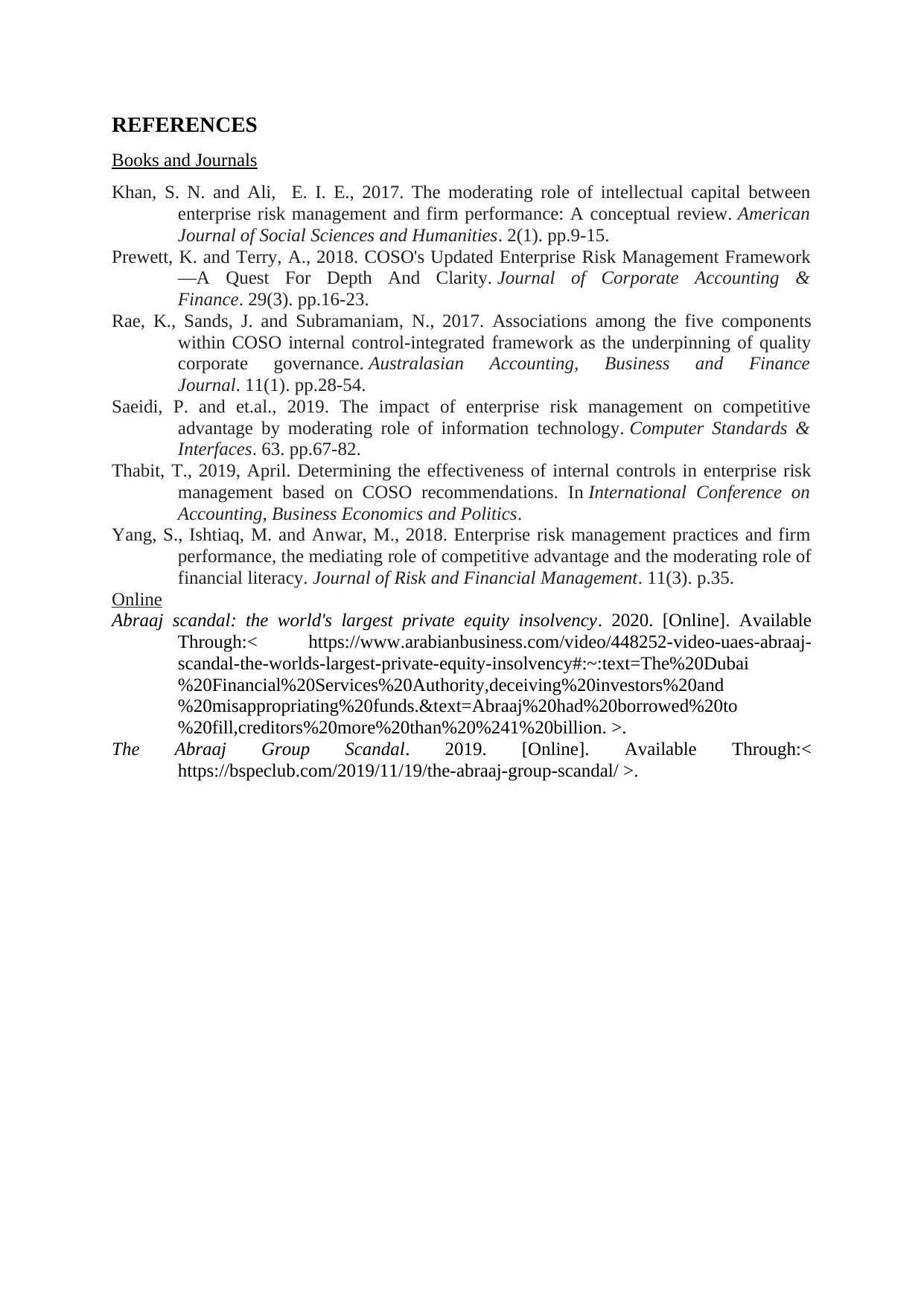
REFERENCES
Books and Journals
Khan, S. N. and Ali, E. I. E., 2017. The moderating role of intellectual capital between
enterprise risk management and firm performance: A conceptual review. American
Journal of Social Sciences and Humanities. 2(1). pp.9-15.
Prewett, K. and Terry, A., 2018. COSO's Updated Enterprise Risk Management Framework
—A Quest For Depth And Clarity. Journal of Corporate Accounting &
Finance. 29(3). pp.16-23.
Rae, K., Sands, J. and Subramaniam, N., 2017. Associations among the five components
within COSO internal control-integrated framework as the underpinning of quality
corporate governance. Australasian Accounting, Business and Finance
Journal. 11(1). pp.28-54.
Saeidi, P. and et.al., 2019. The impact of enterprise risk management on competitive
advantage by moderating role of information technology. Computer Standards &
Interfaces. 63. pp.67-82.
Thabit, T., 2019, April. Determining the effectiveness of internal controls in enterprise risk
management based on COSO recommendations. In International Conference on
Accounting, Business Economics and Politics.
Yang, S., Ishtiaq, M. and Anwar, M., 2018. Enterprise risk management practices and firm
performance, the mediating role of competitive advantage and the moderating role of
financial literacy. Journal of Risk and Financial Management. 11(3). p.35.
Online
Abraaj scandal: the world's largest private equity insolvency. 2020. [Online]. Available
Through:< https://www.arabianbusiness.com/video/448252-video-uaes-abraaj-
scandal-the-worlds-largest-private-equity-insolvency#:~:text=The%20Dubai
%20Financial%20Services%20Authority,deceiving%20investors%20and
%20misappropriating%20funds.&text=Abraaj%20had%20borrowed%20to
%20fill,creditors%20more%20than%20%241%20billion. >.
The Abraaj Group Scandal. 2019. [Online]. Available Through:<
https://bspeclub.com/2019/11/19/the-abraaj-group-scandal/ >.
Books and Journals
Khan, S. N. and Ali, E. I. E., 2017. The moderating role of intellectual capital between
enterprise risk management and firm performance: A conceptual review. American
Journal of Social Sciences and Humanities. 2(1). pp.9-15.
Prewett, K. and Terry, A., 2018. COSO's Updated Enterprise Risk Management Framework
—A Quest For Depth And Clarity. Journal of Corporate Accounting &
Finance. 29(3). pp.16-23.
Rae, K., Sands, J. and Subramaniam, N., 2017. Associations among the five components
within COSO internal control-integrated framework as the underpinning of quality
corporate governance. Australasian Accounting, Business and Finance
Journal. 11(1). pp.28-54.
Saeidi, P. and et.al., 2019. The impact of enterprise risk management on competitive
advantage by moderating role of information technology. Computer Standards &
Interfaces. 63. pp.67-82.
Thabit, T., 2019, April. Determining the effectiveness of internal controls in enterprise risk
management based on COSO recommendations. In International Conference on
Accounting, Business Economics and Politics.
Yang, S., Ishtiaq, M. and Anwar, M., 2018. Enterprise risk management practices and firm
performance, the mediating role of competitive advantage and the moderating role of
financial literacy. Journal of Risk and Financial Management. 11(3). p.35.
Online
Abraaj scandal: the world's largest private equity insolvency. 2020. [Online]. Available
Through:< https://www.arabianbusiness.com/video/448252-video-uaes-abraaj-
scandal-the-worlds-largest-private-equity-insolvency#:~:text=The%20Dubai
%20Financial%20Services%20Authority,deceiving%20investors%20and
%20misappropriating%20funds.&text=Abraaj%20had%20borrowed%20to
%20fill,creditors%20more%20than%20%241%20billion. >.
The Abraaj Group Scandal. 2019. [Online]. Available Through:<
https://bspeclub.com/2019/11/19/the-abraaj-group-scandal/ >.

⊘ This is a preview!⊘
Do you want full access?
Subscribe today to unlock all pages.

Trusted by 1+ million students worldwide
1 out of 9
Related Documents
Your All-in-One AI-Powered Toolkit for Academic Success.
+13062052269
info@desklib.com
Available 24*7 on WhatsApp / Email
![[object Object]](/_next/static/media/star-bottom.7253800d.svg)
Unlock your academic potential
Copyright © 2020–2025 A2Z Services. All Rights Reserved. Developed and managed by ZUCOL.




